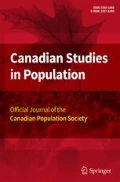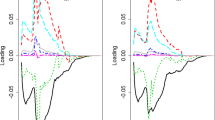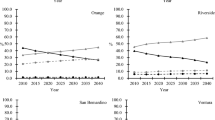Abstract
Early population projections described future changes in total population and could foresee unsustainable population growth. Age-specific population projections could identify trends in population ageing and demographic dividends, and they have been widely used in recent decades owing to the efforts of collecting and estimating demographic data by age. In recent years, data are becoming available to allow for population projections by age and birth parity, which could help understanding future changes in family structures. To take advantage of the opportunity created by these increasingly accessible data, this paper extends the cohort component method to project populations by age and birth parity and provides an application for Canada.
Résumé
Les premières projections démographiques décrivaient les changements futurs de la population totale et pouvaient prévoir une croissance démographique non soutenable. Les projections démographiques par âge pourraient indiquer les tendances du vieillissement de la population et des dividendes démographiques, et elles ont été largement utilisées au cours des dernières décennies grâce aux efforts de collecte et d'estimation des données démographiques par âge. Ces dernières années, les données sur la fécondité par rang de naissance sont devenues de plus en plus disponibles, ce qui permet d’effectuer des projections démographiques par âge et rang de naissance. Ce type de projections pourrait aider à décrire les changements futurs dans les structures familiales. Pour profiter de l’opportunité créée par ces données de plus en plus accessibles, cet article étend la méthode des composantes pour projeter les populations par âge et rang de naissance. Nous proposons ainsi une application de cette méthode pour le Canada.


Similar content being viewed by others
Notes
Survival ratios are used as only age-specific, because of the lack of data and theory that support to specify survival ratios by birth parity.
The fertility rate of parity i in ages (a,a + 1) in year (t,t + 1), fi + 1(a, t), is defined as the ratio of the number of the (i + 1)th births in the year to the person-years of women aged (a,a + 1) in parity i in the year.
Let the probability for a woman to have i children at the maximum reproductive age be pi, the fertility-table total fertility is \( T{F}_f=\sum \limits_ii\cdot {p}_i \).
The reason of using ‘declining’ and the superscript ‘d’ is to exclude the increase for parities bigger than 0,
which is caused by women in a lower parity delivering birth, and is taken into account in population balance
References
Chiang, C. L., & Berg, B. J. V. D. (1982). A fertility table for the analysis of human reproduction. Mathematical Biosciences, 62, 237–251.
Das Gupta, P. (1976). Age-parity-nuptiality-specific stable population model that recognizes births to single women. Journal of American Statistical Association, 71, 308–314.
Dublin, L. I., & Lotka, A. J. (1925). On the true rate of natural increase. Journal of the American Statistical Assocation, 20, 305–339.
Feeney, R. (1983). Population dynamics based on birth intervals and parity progression. Population Studies, 37, 75–89.
Human Fertility Database. (2017). Max Planck Institute for Demographic Research (Germany) and Vienna Institute for Demography (Austria). Available at www.humanfertility.org.
Human Mortality Database. (2017). University of California, Berkeley (USA), and Max Planck Institute for Demographic Research (Germany). Available at www.mortality.org.
Keyfitz, N. (1977). Applied mathematical demography. New York: John Wiley & Sons, Inc..
Leslie, P. H. (1945). On the use of matrices in certain population mathematics. Biometrika, 33, 183–212.
Lee, R., Mason, A., & Members of the NTA Network. (2014). Population aging, dependency, and consumption. Science, 346(6206), 229–234.
Li, N. (2016). Using the probabilistic fertility table to test the statistical significance of fertility trends. Canadian Studies in Population, 43(3–4), 203–214.
Linder, A. (1938). Die Vermehrungsrate der stabilen Bevölkerung. Archiv für Mathematische Wirtschafts und Sozialforschung, IV(2), 136–156.
Lotka, A. J. (1939). Théorie analytique des associations biologique. In D. P. Smith & H. Rossert (Eds.), Analytical Theory of Biological Populations. Amsterdam: Springer 1998.
Park, C. B. (1976). Lifetime probability of additional births by age and parity for American women, 1935–1968: a new measurement of fertility. Demography, 13, 1–17.
Preston, S. H., Heuveline, H., & Guillot, M. (2001). Demography, measuring and modeling population process. Oxford: Blackwell Publishers Ltd.
Pollard, J. H. (1973). Mathematical models for the growth of human population. Cambridge: Cambridge University Press.
Rallu, L. and Toulemon, L. (1994). Period fertility measures. The construction of different indices and their application to France, 1946–89. Population, an English Selection, (6) 59–94.
Sharpe, F. R., & Lotka, A. J. (1911). A problem in age-distribution. Philosophical Magazine, Ser. 6, XXI(1911), 435–438.
United Nations. (1951). The past and future growth of world population — a long-range view. Population Bulletin of the United Nations, No. 1.
United Nations. (2017). World population prospects: the 2017 revision. New York: United Nations.
Whelpton, P. K. (1936). An empirical method for calculating future population. Journal of the American Statistical Association, 31, 457–473.
Author information
Authors and Affiliations
Corresponding author
Ethics declarations
Conflict of Interest
The author declares that there is no conflict of interest.
Additional information
Views expressed in this paper are those of the author’s and do not necessarily reflect those of the United Nations
Appendices
Appendix 1. Formulas for the age-parity-specific population model
For women in the age group (a, a+1) and parity i at time t, the progression to parity i+1 between time t and time t+1 can be described through a life table approach with two decrements: death and giving birth to the (i + 1) th child, which are measured by age-specific death rates and age-parity-specific fertility rates, namely m(a) and fi + 1(a), respectively. Here, time interval (t,t + 1) is omitted for the reason of making the expressions simpler.
Let the forces of mortality and fertility at parity i to be constant within each age and time interval. Then, the forces of mortality and fertility are m(a) and fi + 1(a); and the probabilities of surviving from age a to age (a + x) are e−m(a) ⋅ x and \( {e}^{-{f}_i(a)\cdot x} \), respectively (see Pollard 1973). Further, assuming that death and delivering birth are independent, the decliningFootnote 4 number of women in parity i at age (a + x), namely \( {l}_i^d\left(a+x\right) \), is
where li(a) is the number of women in parity i at age a. Subsequently, the declining person-years are
Consequently, the two-decrement ratio for a woman in parity i to survive from ages (a,a + 1) to ages (a + 1,a + 2), namely Si(a), is
Because the values of m(a) and fi + 1(a) are small, (7) can be written approximately as
Neglecting the product terms between fertility and mortality rates, (8) is further simplified as:
In (9), \( s(a)=\frac{\left[1-m(a)\right]\cdotp \left[1-0.5\times m\left(a+1\right)\right]}{1-0.5\times m(a)} \) is the survival ratio under mortality decrement. The difference between s(a) and the survival ratios based other life-table assumptions are negligible.
When the requirement on accuracy is high, (7) can be implemented by using more accurate but complex formulas. Since (9) is intuitively understandable, it is adopted in this paper.
Specifying now the survival ratio and fertility rate for time interval (t,t + 1) as s(a,t) and fi(a, t), and using (9) for i = 0, the equation for parity 0 is obtained as
where pi(a, t) represents the number of women aged (a,a + 1) in parity i at time t. The number of women in parity 0 declined due to mortality is p0(a, t) ⋅ [1 − s(a, t)]; and these women exited the total population. The number of women declined due to delivering the first birth is p0(a, t) ⋅ [f1(a, t) + f1(a + 1, t)]/2; these women, however, did not exit the total population but entered parity 1 at time (t + 1). Thus, the equation of parity 1 is obtained by applying (9) for i = 1 and keeping the balance of total population as
In the right-hand side of (11), the first term is the number of women declined due to mortality and fertility of parity 1, which is a result of two-decrement process and is obtained from applying (9) for i = 1; and the second term is the number of women entered parity 1 from parity 0 due to delivered the first birth, which is a result of keeping the balance of total population. In general, the equation of parity i is obtained for the same reason as
The equation of the last open parity, however, is different, because women do not exit this parity when delivering an additional child. Thus, the fertility decrement in (9) is excluded, and the result is
Appendix 2. Stability of the age-parity-specific population model
The stable population theory is often attributed to Lotka (1939). Nonetheless, the basic equation and the stable property, which guarantees the age structure of a population converge to a constant one if vital rates remain constant and there is no migration, were published earlier in two papers written by Lotka and his colleagues (Sharpe and Lotka 1911; Dublin and Lotka 1925). Citing these two papers, Linder (1938, p.144) generalized Lotka’s equation and stability property to include dimensions other than age. Linder’s work was written in the form of the Leslie model and is applied to the age-parity-specific population model presented in this paper as indicated below.
Consider the situation of over-time constant vital rates and zero migration, in which equation (2) above (the birth equation of the age-parity-specific population model) can be written as:
In the form of the Leslie model, equation (14) becomes \( {b}_i(t)=\sum \limits_{a={a}_{\mathrm{min}}}^{a_{\mathrm{max}}}{f}_i(a)\cdotp {p}_{i-1}\left(a,t\right) \), to which Linder’s procedure directly applies. However, [pi − 1(a, t) + pi − 1(a, t + 1)]/2 measures the person-years in (a,a + 1) and (t,t + 1) more accurately than pi − 1(a, t) does, and it thus requires an indication that Linder’s procedure is still valid.
By applying equation (1), the survival equation of the age-parity-specific population model, to variable pi − 1(a, t + 1), equation (14) can be written in a form that contains populations only at time t:
Focusing on the populations by age and parity, equation (15) can be reorganized as
where g1i(a) and g2i(a) are functions of the constant vital rates and contain fi(a) as a factor, and are positive at reproductive ages and zero otherwise. Let the total number of births in (t-a, t-a + 1) be B(t-a). Then, pi(a, t)/B(t − a) is determined by the constant viral rates and can be defined as the probability of a female birth to be in parity i at ages (a,a + 1), namely Pr(a, i| birth):
Applying equation (17) to (16), a special case of Linder’s generalized equation is obtained as follows:
In equation (18), summing up the functions in the large bracket over all the parities gives a function of age a, namely ϕ(a):
It is clear that ϕ(a) is positive in (amin − 1, amax) and zero otherwise. Since the minimal reproductive age is itself flexible, ϕ(a) is equivalent to the net maternity function of Lotka’s equation. Subsequently, summing for all birth orders in equation (18), the total number of births becomes a discrete form of Lotka’s equation (see Pollard 1973; p.24):
By applying Lotka’s procedure for proving that the continuous version of equation (20) is stable, B(t) will converge to a stable state regardless of initial conditions. If vital rates are constant in equation (18), bi(t) and population size at all ages and parities will also converge to stable states.
Rights and permissions
About this article
Cite this article
Li, N. Projecting Population Change by Age and Birth Parity: the Third Generation of Population Projections. Can. Stud. Popul. 47, 169–182 (2020). https://doi.org/10.1007/s42650-020-00021-z
Received:
Accepted:
Published:
Issue Date:
DOI: https://doi.org/10.1007/s42650-020-00021-z




